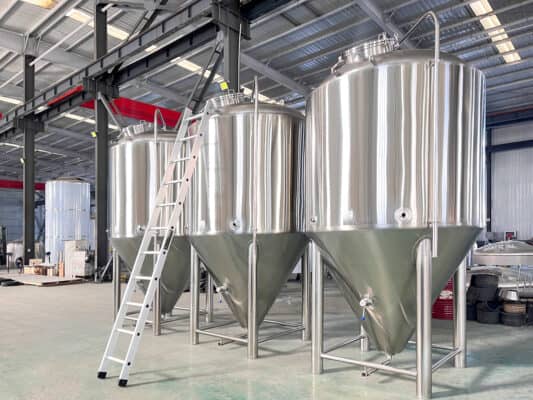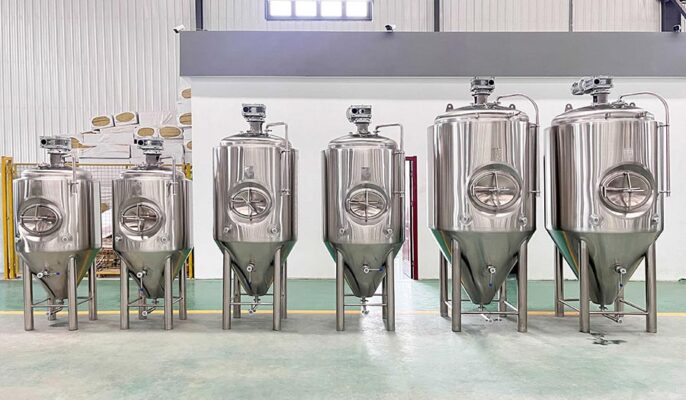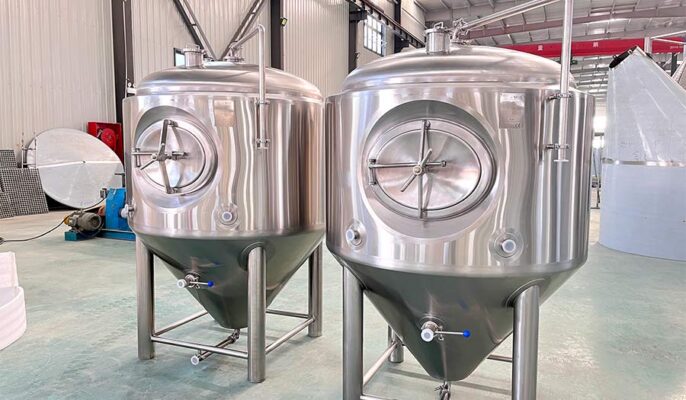Ausrüstung für die Biergärung is a critical step in brewing that requires specialized equipment to control temperature, oxygen exposure, and fermentation speed for optimal flavor. This guide provides an introduction to common beer fermentation system types, components, suppliers, and considerations when choosing equipment.
The Brewing Symphony: Orchestrating Flavor with Fermentation Equipment
Fermentation is the stage where magic happens in brewing. The sweet wort transforms into the beloved beverage we know and love, thanks to the delicate dance of yeast and temperature. But just like any symphony, this transformation requires the right instruments – in this case, the diverse tapestry of fermentation equipment. Let’s explore the key players on this brewing stage:
Center Stage: The Fermenters
At the heart of fermentation lie the vessels where the liquid dreams of beers are born. For homebrewers, glass carboys offer a clear view of the bubbling action, while plastic buckets provide affordability and ease of handling. Professional brewers graduate to stainless steel tanks, boasting durability, hygiene, and temperature control capabilities.
Konische Fermenter reign supreme, their tapered bottoms aiding in yeast sediment collection and easy cleaning. Open-top fermenters add a rustic touch, allowing brewers to interact with the fermenting wort, though requiring extra precautions against contamination. For lagers, horizontal conditioning tanks provide ample space for slow, cold fermentation.
Supporting Cast: Essential Companions
Fermentation demands more than just a vessel. Airlocks act as silent guardians, allowing CO2 to escape while preventing unwanted air from entering. Hydrometers become the conductor, measuring sugar levels to track fermentation progress. Temperature control systems ensure the yeast performs its magic at the optimal pace, while pressure regulators manage carbonation for sparkling finishes.
Specialty Sections: Adding Uniqueness
For brewers seeking distinctive flavors, specialized equipment awaits. Fässer aus Holz impart oaky notes, while koji chambers introduce unique Asian flavors. Conditioning tanks with special spunding valves allow precise control over carbonation levels. These tools become the soloists, adding individual character to the overall brew.
The Final Act: Bottling and Kegging
The grand finale sees the beer packaged for enjoyment. Flaschen offer portability and long-term storage, while kegs provide draft systems for pubs and home bars. Fillers and cappers become the stagehands, ensuring each vessel is sealed with care.
From the humble carboy to the sophisticated conditioning tank, each piece of fermentation equipment plays a vital role in crafting the perfect beer. It’s through this orchestration of tools and techniques that brewers bring their unique melodies to life, transforming simple ingredients into symphonies of flavor. So, the next time you raise a glass, remember the unseen instruments that made it possible.
Key Components of Ausrüstung für die Biergärung
Beer fermentation systems consist of tanks, temperature control, transfer systems, monitoring devices, and cleaning mechanisms:
| Komponente | Beschreibung |
|---|---|
| Gärgefäß | A container where wort is fermented by yeast. |
| Schleuse | A device that allows gas to escape while preventing contaminants from entering the vessel. |
| Thermometer | Used to monitor and control fermentation temperature. |
| Aräometer | Measures the specific gravity of the wort, helping to determine the progress of fermentation. |
| Rohrstock | Used for transferring beer from one vessel to another while leaving sediment behind. |
| Fermentation Lock | Provides a barrier to air and bacteria during fermentation. |
| Auto-Siphon | A tool for siphoning beer from one vessel to another more easily. |
| pH Meter | Monitors the acidity of the beer during fermentation. |
| Temperaturkontrolle | Devices like heating belts or cooling jackets to maintain fermentation temperature. |
| Sampling Thief | Used to take samples of beer for testing and tasting during fermentation. |
| Yeast Pitching Tools | Instruments for adding yeast to the wort, such as yeast starters or pitch forks. |
| Reinigungsmittel | Brushes, cleaners, and sanitizers to maintain cleanliness and prevent contamination. |
Functions of Beer Fermentation Equipment
In the symphony of brewing, the fermentation stage plays a pivotal role, transforming sweet wort into the flavorful, effervescent beer we know and love. To ensure this musical masterpiece hits the right notes, brewers rely on a diverse range of specialized equipment, each playing a distinct part in the grand performance.
The centerpiece of this equipment orchestra is the Gärbehälter, a haven for the wort and its industrious yeast companions. These tanks provide a controlled environment, maintaining the ideal temperature for the specific yeast strain. Think of them as temperature-controlled concert halls, ensuring the yeast performs at its peak. Different vessel types like fermenters and conditioning tanks offer their own nuances, affecting aspects like pressure and clarity.
Next up are the temperature control systems, acting as the conductor of the thermal symphony. They meticulously regulate the vessel’s temperature, guiding the yeast through its metabolic dance. Imagine them as thermostats with a deeper understanding of beer, ensuring the yeast doesn’t get too hot or cold, leading to off-flavors or sluggish fermentation.
Then there’s the aeration equipment, responsible for adding just the right amount of oxygen during the early stages of fermentation. Oxygen acts as a wake-up call for the yeast, kickstarting its multiplication and setting the stage for vigorous sugar consumption. Picture them as backstage assistants, ensuring the yeast has the energy it needs to truly shine.
For some beer styles, pressure control systems join the band, applying gentle or significant pressure depending on the desired outcome. This pressure manipulation influences factors like carbonation levels and yeast activity, adding another layer of complexity to the brewing process. Think of them as sound engineers, shaping the carbonation “fizz” and ensuring the perfect balance of flavors.
Finally, monitoring and sampling equipment act as the audience, providing valuable feedback throughout the fermentation. Brewers use tools like hydrometers and refractometers to measure sugar levels, gauging the progress of the transformation. Sampling ports allow them to taste and assess the flavor development, ensuring the beer is heading in the right direction. They’re like the critics in the wings, offering insights that help brewers fine-tune their creation.

Choosing a Supplier
| Schritt | Criteria for Selection | Beschreibung |
|---|---|---|
| 1 | Research & Identify Potential Suppliers | Start by researching potential suppliers through online searches, industry directories, trade shows, and recommendations from other brewers. Create a list of options. |
| 2 | Assess Reputation & Credibility | Look for reviews, testimonials, and ratings to gauge the reputation of each supplier. Check if they have relevant certifications or industry affiliations. |
| 3 | Evaluate Product Range | Examine the range of fermentation equipment offered by each supplier. Ensure they offer the specific equipment you need, such as fermentation tanks, cooling systems, etc. |
| 4 | Quality & Durability | Assess the quality and durability of the equipment. Inquire about the materials used, manufacturing processes, and any warranties provided. |
| 5 | Pricing and Budget | Obtain quotes from multiple suppliers for the same equipment. Compare pricing, including shipping costs and any additional fees. Ensure it fits your budget. |
| 6 | Kundenbetreuung | Inquire about the level of customer support offered. Check if they provide technical assistance, troubleshooting, and after-sales service. |
| 7 | Lead Times and Availability | Ask about lead times for manufacturing and delivery. Ensure they can meet your project timeline and have equipment readily available or customizable. |
| 8 | References and Past Clients | Request references or contact information for past clients who have purchased from the supplier. Get feedback on their experiences. |
| 9 | Compatibility and Customization | If you have specific requirements or need custom equipment, verify if the supplier can accommodate customization and if the equipment meets industry standards. |
| 10 | Payment Terms and Contracts | Review payment terms, contracts, and return policies. Ensure transparency in pricing and terms, and consider negotiating if necessary. |
| 11 | Location and Logistics | Consider the supplier’s location in relation to your brewery. Evaluate shipping costs, import/export regulations, and potential logistics challenges. |
| 12 | Environmental Considerations | Assess the supplier’s commitment to sustainability and eco-friendly practices if environmental concerns are important to your brewery. |
| 13 | Visit the Supplier (if possible) | If feasible, visit the supplier’s facilities to inspect equipment quality and build a closer relationship. |
| 14 | Make a Final Decision | Based on your research and evaluations, select the supplier that best aligns with your needs, budget, and trustworthiness. |
| 15 | Negotiate Terms | Negotiate terms and finalize the contract with the chosen supplier. Ensure all details are clear and agreed upon. |
| 16 | Monitor Performance | After procurement, monitor the supplier’s performance, delivery times, and equipment quality to ensure ongoing satisfaction. |
Installation, Operation & Maintenance
Brewing delicious beer starts with the right equipment, but mastering it requires understanding installation, operation, and maintenance. Let’s delve into each stage of this brewing journey:
Installation: Building the Brewing Stage
1. Know Your Equipment: Thoroughly read the manufacturer’s manuals and understand each component’s function and specifications.
2. Location, Location, Location: Choose a designated space with proper ventilation, access to utilities (water, drainage, electricity), and adequate floor support for heavier equipment.
3. Assemble with Care: Follow the provided instructions, double-checking connections and seals for leaks. Ensure proper grounding for electrical components.
4. Calibration Concerto: Calibrate thermometers, hydrometers, and pressure gauges with manufacturer-recommended procedures for accurate readings.
5. Sanitization is Key: Before your first brew, perform a thorough sanitization of all equipment using specialized cleaning solutions. Rinse and air dry completely.
Operation: Conducting the Fermentation Dance
1. Recipe Rhythm: Follow your chosen recipe, paying close attention to fermentation temperatures, pressure levels, and timing. Consistency is crucial!
2. Monitoring the Melody: Regularly check temperatures with calibrated thermometers. For larger setups, invest in automated monitoring systems.
3. Airlock’s Aria: Ensure airlocks function properly, allowing CO2 to escape without letting contaminants enter.
4. Hydrometer Harmony: Periodically measure gravity with a hydrometer to track fermentation progress and estimate completion time.
5. Siphon Symphony: Carefully transfer your beer between vessels using sanitized siphons, minimizing sediment disturbance.
6. Bottling or Kegging: Choose your desired packaging method and ensure proper filling, capping, or carbonation techniques.
Maintenance: Keeping the Instruments in Tune
1. Cleaning Cadence: After each use, meticulously clean and sanitize all equipment with appropriate solutions. Follow specific guidelines for each component.
2. Regular Inspections: Periodically inspect for leaks, worn-out parts, or damage. Address any issues promptly to maintain optimal performance.
3. Lubrication Lullaby: Lubricate moving parts according to manufacturer recommendations to prevent wear and tear.
4. Storage Serenade: When not in use, store equipment in a clean, dry environment to prevent rust and contamination.
5. Calibration Continuity: Regularly recalibrate thermometers, hydrometers, and pressure gauges to ensure accurate readings throughout your brewing journey.
By following these steps and consulting specific manufacturer instructions, you can ensure your fermentation equipment performs like a well-tuned orchestra, producing delicious, consistent beers for years to come. Remember, practice makes perfect, and with each batch, you’ll become a maestro of your own brewing symphony.
Comparing Pros and Cons of Fermentation Systems
| Gärsystem | Profis | Nachteile |
|---|---|---|
| Batch Fermentation | – Simple and cost-effective | – Limited control over process parameters |
| – Easy to set up and operate | – Requires frequent monitoring | |
| – Suitable for small-scale production | – Inconsistent product quality | |
| – Minimal equipment and space required | – Longer batch-to-batch variation | |
| – Flexibility in product diversity | – Lower overall productivity | |
| Continuous | – High productivity and yield | – Complex setup and maintenance |
| Gärung | – Steady-state operation | – Higher capital investment |
| – Reduced labor and monitoring needs | – Difficult to switch between products | |
| – Efficient use of resources | – Potential for contamination | |
| – Consistent product quality | – Limited flexibility in product range | |
| – Suitable for large-scale production | ||
| Fed-Batch | – Better control over nutrient addition | – Requires skilled operators |
| Gärung | – Enhanced product concentration | – Complex process design |
| – Lower risk of contamination | – Longer batch duration | |
| – Improved product quality | – Increased operating costs | |
| – Flexibility in product variations | ||
| – Suitable for medium to large-scale | ||
| production |
FAQ
What size fermentation system do I need?
Base tank volumes on annual beer production goals. Allow 30-50% extra capacity for peak times and future growth. Or consider starting small with room to add tanks.
What temperature control method should I use?
Glycol chilling is most precise for lager yeast strains. Steam heating offers flexibility for ales. Consider humidity and desired temperature parameters.
How many fermenters should I have?
A minimum of two allows you to separate beer batches by age. Larger breweries may use 8-12+ tanks for workflow flexibility.
What is beer fermentation equipment?
Beer fermentation equipment includes various tools and vessels used in the fermentation process of beer production. It typically consists of fermenters, airlocks, temperature control devices, and other accessories.
Why is fermentation equipment important in brewing beer?
Fermentation equipment is essential because it provides a controlled environment for yeast to convert sugars into alcohol and carbon dioxide, which is a crucial step in brewing beer.
What are the different types of fermentation vessels?
Common types of fermentation vessels include conical fermenters, carboys, plastic buckets, and stainless steel tanks. Each has its advantages and disadvantages.
Mehr wissen Brauereiausrüstung






